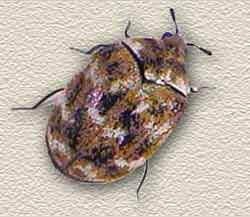Carpet Beetle Control: Protect Your Home or Business

Facts
- Carpet beetle larvae eat natural, high-protein materials like human hair and pet dander.
- Depending on the species, female carpet beetles can lay over 100 eggs at a time.
- Many people mistake these insects for ladybugs due to their small, rounded bodies.
Appearance
Adults
Most mature carpet beetles measure a quarter-inch in length, which is about the size of a pencil eraser. Some are solid black and may appear dull or shiny. Others have color patterns of gray, tan, and brown. Both varieties have wings tucked beneath hard casings on their backs.
Larvae
The pests’ offspring are roughly half an inch in length. Black carpet beetle larvae are golden brown with long, tail-like hairs at the ends of their tapered bodies. In contrast, dark bristles cover the varied beetle larva’s entire oblong-shaped body.
How Do Carpet Beetles Get Inside Buildings?
People often bring the pests indoors via infested secondhand rugs or clothes. In addition, mature insects can simply fly through ripped screens or open doors. As pollen eaters, adult carpet beetles may hitch rides on cut flowers or garden plants brought inside, too.
In craft stores and retail shops, carpet beetle eggs or larvae may hide in fabric, yarn, or clothing made with organic fibers. Problems in commercial warehouses and storage units can begin when rats or birds nest in the building, as juvenile carpet beetles feed on the animals’ fur or feathers.
Signs of Carpet Beetle Infestation
- Cast-Off Skins – Carpet beetle larvae molt several times, frequently discarding cast-off skins on surfaces where they’ve fed.
- Damage – Larvae consume natural materials such as silk, wool, and leather. As a result, they leave large, ragged holes or threadbare spots on clothing, blankets, and furniture.
- Sightings – It’s common to see one or two carpet beetles in your home. Discovering dozens of beetles flying around sunlit windows or finding active larvae indicates a more serious issue.
Problems Caused by Carpet Beetles
Wool sweaters, heirloom rugs, and down sleeping bags kept in cardboard boxes are vulnerable to damage, and it can go unnoticed for years. Even prized hunting mounts are at risk for bald patches. Additionally, carpet beetle larvae are pantry pests that eat and contaminate grains and cereals, dried fruit, or powdered milk.
Rug retailers, as well as fabric and consignment shops, can suffer widespread damage to their merchandise. As stored product pests, carpet beetle larvae affect restaurants by getting into spices, flour, and other staples. Supermarkets and pet supply stores may find dry dog and cat food polluted by the insects as well.
Prevention Tips
Carpet beetle larvae can find meals almost anywhere, making them difficult to remove. They travel unseen through heating ducts and behind baseboards. Sanitation and awareness play a big role in preventing infestation. Some deterrents include:
- Vacuuming areas that collect dust, loose hair, and animal dander. Baseboards and spaces beneath furniture, appliances, and equipment trap lint and other debris easily.
- Keeping windows, vents, and doors sealed to prevent the insects from coming indoors.
- Washing or dry cleaning secondhand clothes, quilts, or toys after purchase.
- Storing clean wool, silk, leather, or cotton items in pest-proof boxes.
- Checking fresh-cut wildflowers or inspecting foliage before bringing plants inside.
Carpet beetle larvae scatter throughout a building quickly and hide in dark places, making it a challenge to detect and remove an infestation without help. If you have a problem with these insects in your home or business, contact our experts at Western Pest Services.